Key takeaways:
- Butterfly conservation safeguards entire ecosystems, highlighting the interdependence of species and habitats.
- Habitat restoration is crucial for revitalizing not just butterflies but broader biodiversity, providing food and shelter for various wildlife.
- Community involvement and education are vital aspects of conservation efforts, fostering future generations’ appreciation for nature.
- Personal experiences in restoration underscore the emotional rewards and challenges, emphasizing persistence and community connections in conservation work.
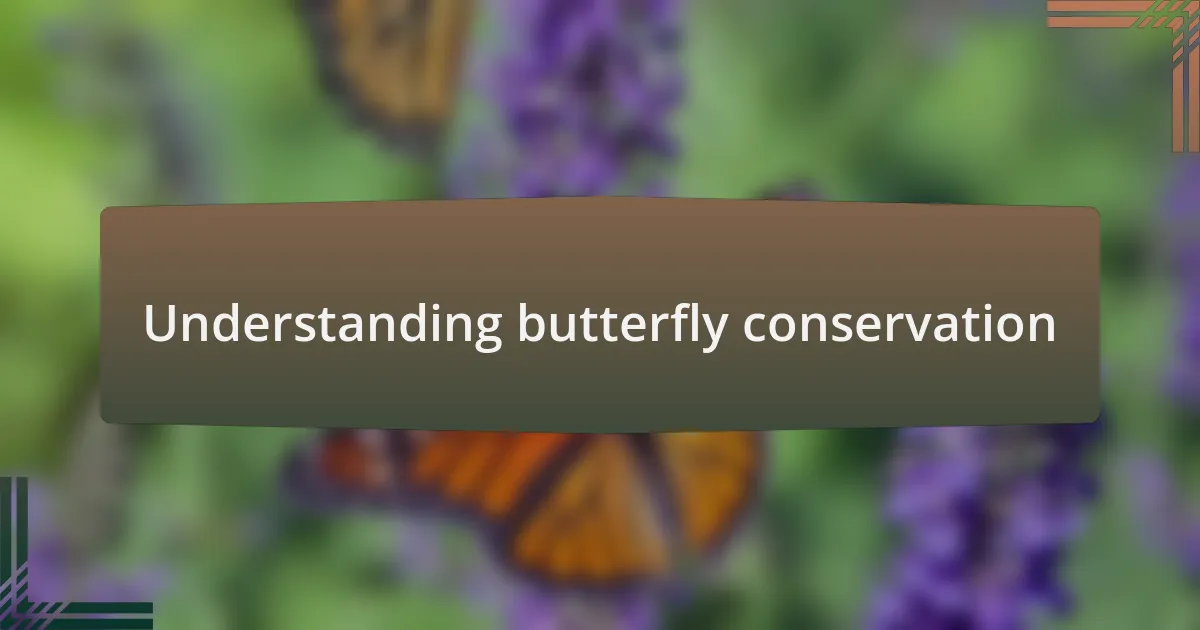
Understanding butterfly conservation
Butterfly conservation is about much more than just protecting a pretty insect; it’s about safeguarding an entire ecosystem. I remember the first time I stumbled upon a butterfly garden in my community. Surrounded by fluttering colors, I felt an overwhelming sense of joy, realizing that each butterfly plays a crucial role in pollination and maintaining plant diversity.
Have you ever considered how much butterflies rely on specific habitats? It’s fascinating to think that their survival depends on particular plants to lay their eggs. During my habitat restoration project, I witnessed firsthand how planting native species can rejuvenate local butterfly populations. The transformation was dramatic, with more butterflies gracing the area than I had seen in months.
When I think about the challenges butterflies face, like habitat loss and climate change, it stirs a deep sense of concern. I often wonder: what can each of us do to make a difference? By participating in conservation efforts, we can create safe havens for these beautiful creatures and ensure that future generations will also have the chance to marvel at them.
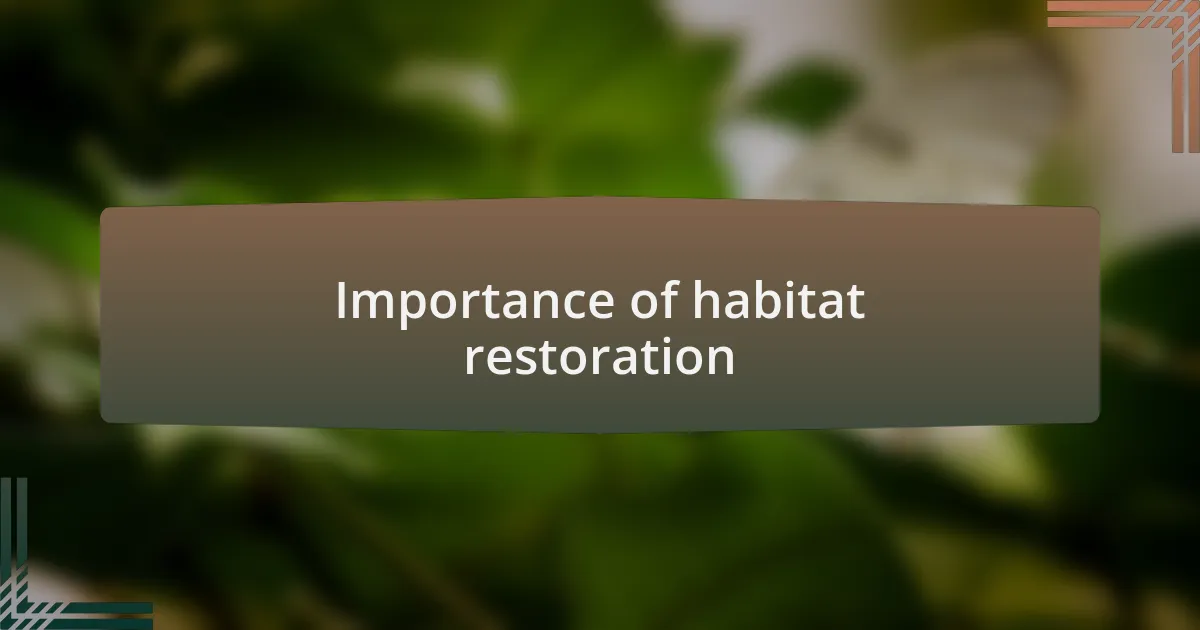
Importance of habitat restoration
Restoring habitats, especially for butterflies, is essential for maintaining ecological balance. I remember planting milkweed during a community cleanup—seeing it thrive was rewarding and vital, as these plants serve as the main food source for monarch caterpillars. Without such restoration efforts, we risk the ongoing decline of not just butterflies but other interconnected species as well.
Moreover, I often reflect on how habitat restoration serves much more than just the needs of butterflies. It revitalizes entire ecosystems, providing shelter and food sources for various wildlife. It’s a beautiful cycle; when we restore a habitat, we’re not just aiding one species—we’re enhancing biodiversity and supporting the earth’s delicate web of life.
When I think back to my days volunteering for habitat restoration, I visualize the vibrant environment that emerged from our hard work. It’s incredible how nature responds when given a chance; once barren land can blossom into a thriving sanctuary. Have you ever felt a profound connection to nature after witnessing such change? That sense of fulfillment underscores the importance of our collective effort in habitat restoration.
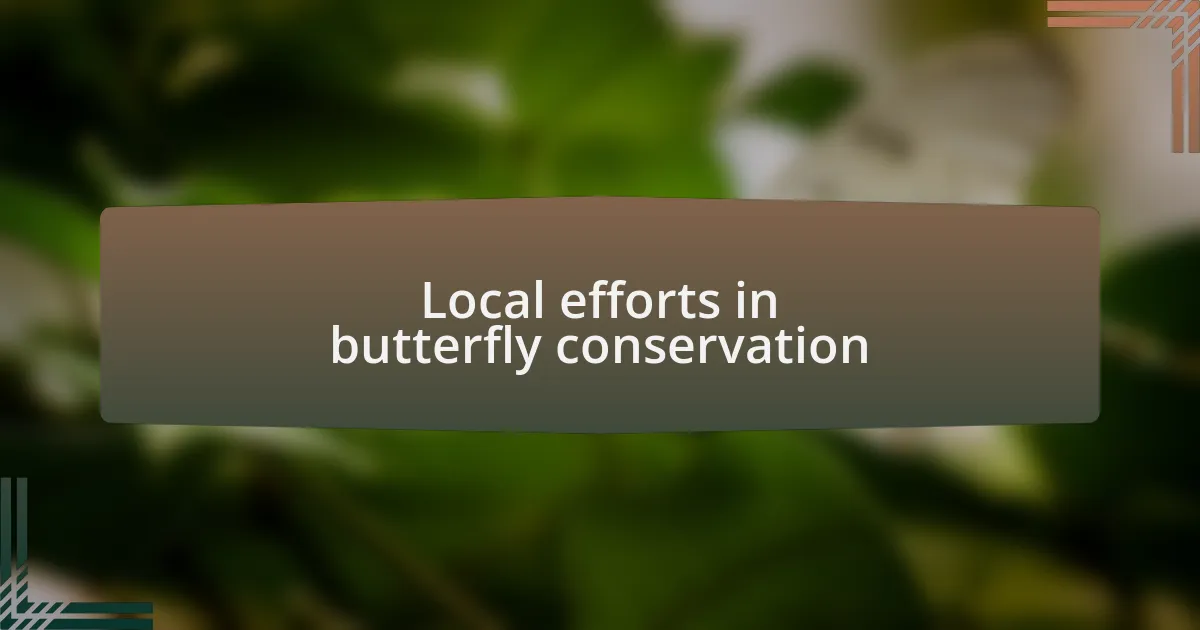
Local efforts in butterfly conservation
Local efforts in butterfly conservation often manifest through dedicated community projects. On one occasion, I joined a local group focused on creating butterfly gardens in public parks. As we placed nectar-rich flowers, it was fascinating to observe the immediate interest from pollinators. Have you ever noticed how a small garden can vibrate with life when given the right plants? It truly illustrates the impact of our actions.
I also recall a particularly rainy weekend spent helping to restore a natural wetland area. It was a messy job, yet each muddy step brought us closer to reviving butterfly habitats. Walking away, I felt a proud connection to the land, knowing that we had taken a vital step toward supporting the essential breeding grounds of various butterfly species. Isn’t it inspiring to think about how such efforts, even in challenging conditions, contribute to the greater good?
Another project I participated in involved working with local schools to educate kids about butterfly conservation. I vividly remember the excitement on their faces as they released newly hatched butterflies into a garden we had nurtured together. Seeing their enthusiasm for protecting these delicate creatures reminded me that future conservationists are being shaped through these local initiatives. Isn’t it heartwarming to know that we are nurturing a new generation of nature advocates?
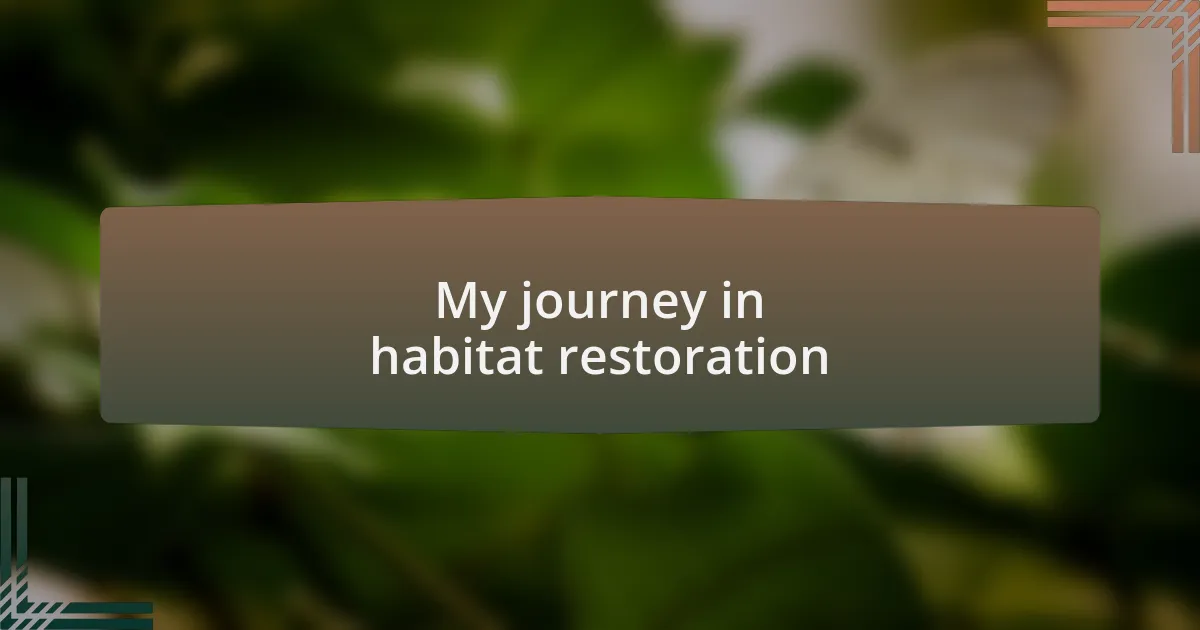
My journey in habitat restoration
It’s incredible how engaging in habitat restoration can change your perspective on nature. I remember one sunny afternoon when we tackled invasive plant species in a nearby meadow. As we worked together, I felt a sense of camaraderie with my fellow volunteers, united by a common goal. Have you ever felt that surge of energy when you see real progress coming from your efforts?
One moment that stands out for me occurred when we added native plants, specifically milkweed, back into the landscape. I felt a rush of joy as I imagined the Monarchs that would return to this enriched habitat. It was as if I was planting hope along with those seedlings. Can you picture the butterflies fluttering around, revitalized by these efforts?
Engaging with nature in this way has deepened my appreciation for the delicate balance of ecosystems. During one such project, we gathered around a veteran conservationist who shared stories of how restorations had transformed entire landscapes. Listening to those experiences was not only enlightening; it sparked a desire in me to continue this important work. Isn’t it incredible how sharing knowledge can inspire a new wave of conservationists?
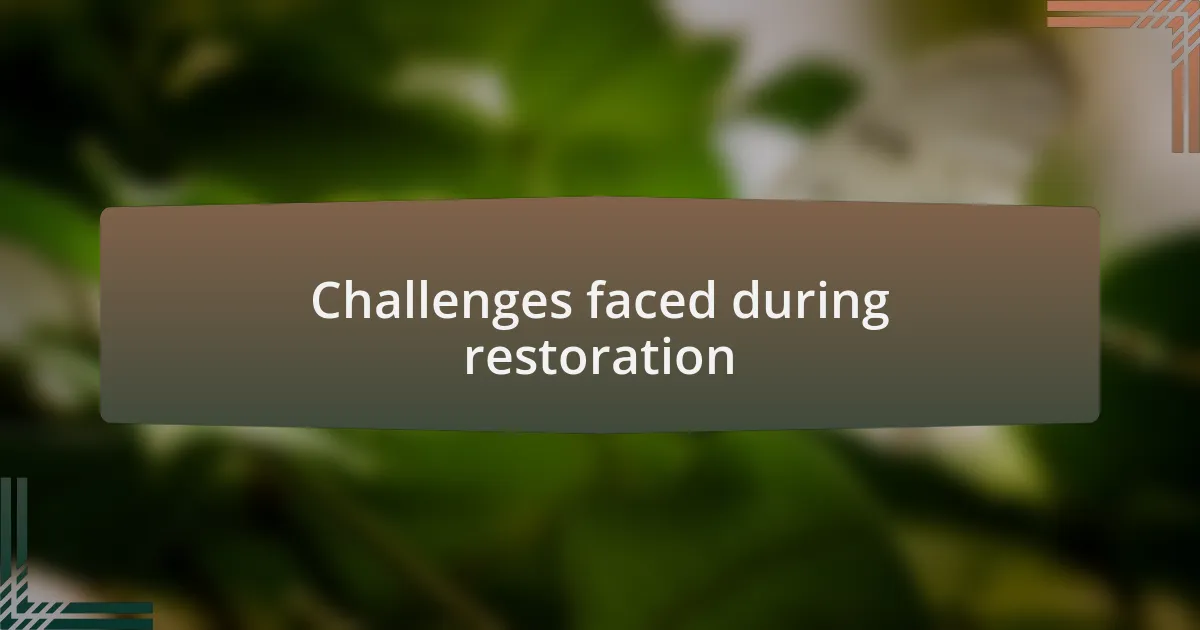
Challenges faced during restoration
One of the most significant challenges I encountered during the restoration process was overcoming the sheer magnitude of invasive species. I still remember the frustration felt when we realized a particularly aggressive plant had re-colonized areas we had just cleared. It begs the question: how do you stay motivated when your efforts feel like they’re in vain? I found that focusing on small victories, like a section of the meadow blooming with native plants, helped me push through the setbacks.
Weather conditions also posed hurdles we hadn’t fully anticipated. I recall a moment when a sudden downpour turned a planned planting day into a muddy struggle. The ground was too wet, and our intended efforts felt thwarted. How do you adapt to such unpredictability in nature? It became a valuable lesson in flexibility; we learned to have backup plans and simply embrace the messiness of restoration work.
Engaging with the community was another layer of complexity we encountered. While many were excited to join our efforts, some were hesitant or indifferent to the importance of habitat restoration. I often wondered, how do you spark genuine interest in something so crucial yet often overlooked? I believe fostering open conversations about the benefits of restoring native habitats was key, but it required patience and persistence. Those discussions not only helped bridge gaps but also deepened my resolve to convey the vital role each individual plays in conservation.
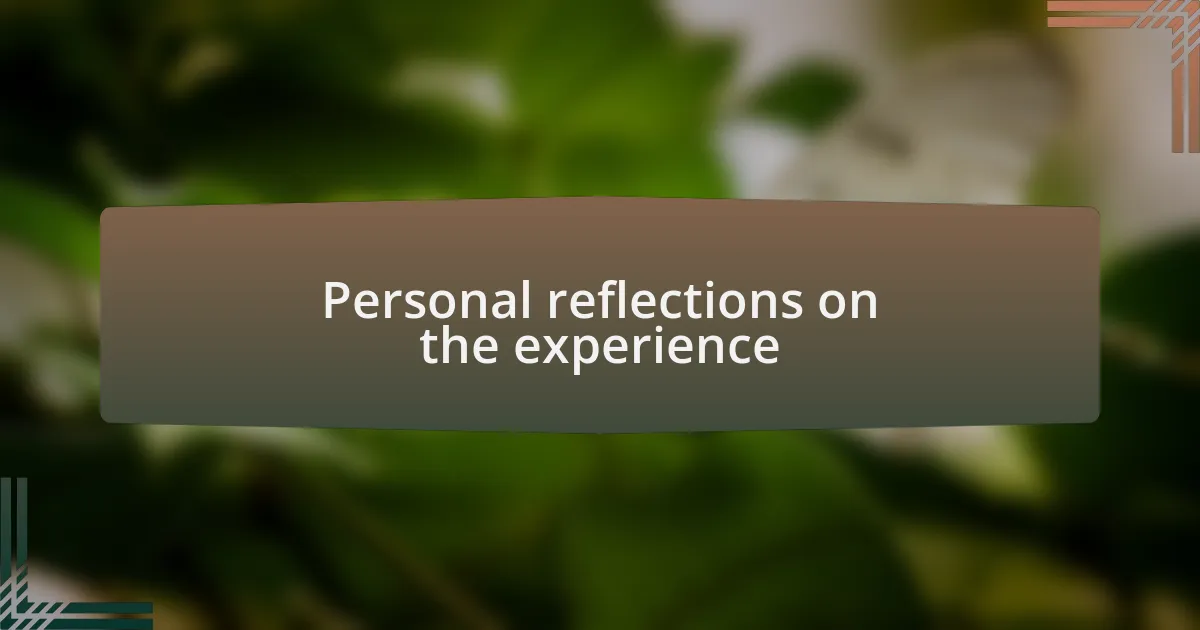
Personal reflections on the experience
Reflecting on my experience, I realize the emotional rollercoaster that comes with habitat restoration. There were days when the progress felt monumental, like the moment I spotted the first butterfly in a newly planted patch of wildflowers. That sight filled me with hope, reminding me why I was there in the first place. Isn’t it incredible how a small creature can reignite your passion for such a daunting task?
I also had moments of doubt that really challenged my motivation. Like the time I returned to an area where I had invested so much effort, only to find it littered with trash again. I remember feeling disheartened and questioning whether my work truly mattered. But then, I thought about the importance of persistence—if we give up, won’t we be depriving future generations of these natural spaces?
What struck me most was the sense of community that blossomed through our shared efforts. There was a heartwarming moment during one of our planting days when a family brought their children along, and I could see their eyes light up as they learned about native plants. It made me reflect: What if this experience sparked a lifelong passion in those kids? Moments like these reinforced my belief that, while the challenges are real, the connections we forge and the awareness we create are invaluable in the fight for conservation.

Impact on local butterfly populations
Engaging in habitat restoration has a profound impact on local butterfly populations. I vividly remember the first time I noticed an increase in butterfly sightings in areas we had revitalized. It was exhilarating to see diverse species flitting about—like the majestic Monarchs dancing among the newly bloomed milkweed. This wasn’t just a personal victory; it was a sign of a healthier ecosystem, where butterflies could thrive again.
One day, while observing the freshly planted native flora, I stumbled upon a cluster of caterpillars munching away. That moment made me realize the direct relationship between our restoration efforts and the lifecycle of butterflies. Isn’t it fascinating how revitalizing a local habitat can create the conditions for new life? It reinforced my belief in the strong connection we hold with nature; what we do truly has a lasting impact.
Interestingly, I learned about the importance of host plants during our projects. Each butterfly species has specific needs when it comes to laying eggs and feeding. I once felt a rush of excitement after discovering that we’d successfully planted the ideal host plants for the endangered Skipper species. The thought that our efforts could help revive such a delicate population gave me a deeper appreciation for the nuances of conservation work. It made me question: How many other species are waiting for us to make the right choices in their habitats?